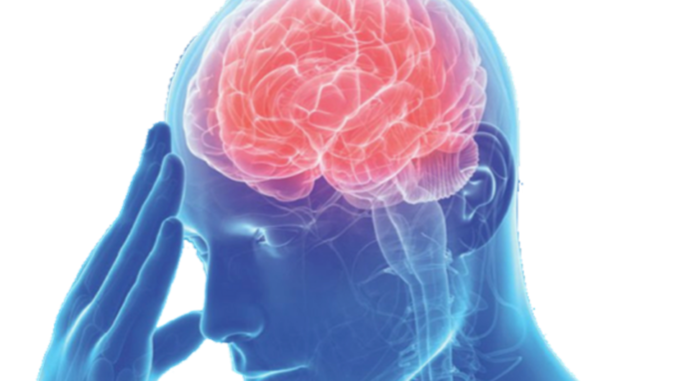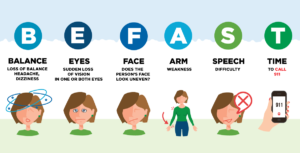
Table of Contents
What is Stroke?
- Stroke, often commonly known as brain attack, is a condition when something blocks blood supply to the brain or when the blood vessel in the brain bursts out.
- A stroke is an acute clinical event that causes a focal or generalized neurological disturbance that is connected to impaired cerebral blood flow and lasts for more than 24 hours and results in death with no other known cause than vascular origin.
- It occurs when a blood artery in the brain bursts and starts to bleed, or when the brain’s blood supply is interrupted.
- Stroke gets its name from the way it strikes people out and is a medical emergency that require prompt care.
- During stroke, brain cells rapidly start to degrade due to lack of oxygen and without the removal of waste materials.
- Early intervention can prevent brain damage and difficulties.
Key Facts
- Stroke is the third most common cause of disability and the second most common cause of death worldwide.
- Its risk affects one in four persons over their lifetime.
- Around the globe, 15 million people experience a stroke each year.
- Five million of them pass away, and another five million become permanently disabled, burdening the family and the community.
- Younger people (less than 40 years) are less likely to experience it and when they do, high blood pressure is the main cause. However, 8% of children with sickle cell disease also experience strokes.
- The two risks that can be changed the most are high blood pressure and smoking.
- Four victims out of every ten who pass away could have been saved if their blood pressure had been controlled. Smoking is to account for two-fifths of stroke deaths in those under 65.
Types
Stroke is mainly three (3) types:

1. Transient Ischemic Attack (TIA)
- Sometimes, it is referred to as a “mini-stroke.”
- It differs from other primary kinds of stroke because the blood flow to the brain is reduced for a short time—typically no more than 5 minutes.
2. Ischemic stroke (IS)
- An arterial obstruction brought on by a clot or plaque refers IS .
- The symptoms and after effects of an ischemic may last indefinitely or linger for a longer period of time.
3. Hemorrhagic stroke
- A blood vessel that bursts or leaks into the brain causes a hemorrhagic stroke.
- The leaked blood puts too much pressure on the brain cells and thus damaging them.
Causes of Stroke
- A blocked artery (ischaemic) or a blood vessel leak or bursts (hemorrhagic) are the two basic causes of stroke.
- Some people may only have a temporary interruption in blood flow to the brain, with no long-lasting effects.
Risk factors
1. Lifestyle factors
- Overweight/obesity
- Sedentary lifestyle
- Heavy drinking/alcoholism
- Use of cocaine, methamphetamine and other illegal drugs
2. Medical risk factors
- High blood pressure
- Smoking
- Diabetes
- Family history of stroke
- High cholesterol
- Heart defects, heart infection or irregular heart rhythm
- Obstructive sleep apnea COVID-19 infection
3. Other risk factors
- Age: People of age 55 years or more have higher risk of stroke.
- Race or ethnicity: African Americans and Hispanics have higher risk of stroke than other races or ethnic groups.
- Sex: Men have higher risk of stroke than women.
- Hormones: Use of birth control pills and hormones increases the risk of stroke.
Moreover, risk factors of stroke can also be segregated as modifiable and non-modifiable factors:
Modifiable risk factors
- Hypertension
- Diabetes
- Obesity
- Smoking
- Poor diet/nutrition
- Sedentary lifestyle
- Cardiovascular disease
- Excess alcohol consumption
- Dyslipidemia
Non-modifiable risk factors
- Age
- Sex
- Race or ethnicity
- Heredity
- High fibrinogen
- Past vascular events

Signs and Symptoms
- Difficulty communicating and hearing. Uncertainty, slurring of words, or trouble understanding speech
- Face, arm, or leg numbness or paralysis abrupt weakness, paralysis, or numbness in the arm, leg, or face. Usually, just one side of the body is impacted. Additionally, when trying to smile, one side of the mouth may droop.
- Vision issues in one or both eyes, one or both eyes may experience abrupt blurriness or blindness, or may have double vision.
- A sudden, intense headache that may be followed by nausea, dizziness, or altered level of consciousness may be an indication of a stroke.
- Difficulty walking stumble or become unsteady. May also experience a loss of coordination or unexpected dizziness.
Diagnosis
- Physical examinations and examination of brain scan pictures are typically used to identify strokes.
- Brain scan pictures can be done through MRI, CT scan, ECG, etc.
- To confirm the diagnosis and identify the underlying etiology, a number of tests can be carried out.
- These may consist of:
- Blood test to determine the amount of cholesterol and blood sugar
- Pulse check for irregular heartbeats
- Blood pressure measurement.
- Additionally, while looking for warning signs, remember to BE FAST
B – Balance, loss of balance as well as headache and dizziness
E – Eyes, a sudden loss of vision in one or both eyes
F – Face, does the face appear uneven?
A – Arm, a feeling of weakness in them
S – Speech, difficulty speaking and forming sentences
T – Time, it is time to call 9-1-1 or your country’s emergency health number

Complications
- Deep vein thrombosis
- Seizures
- Pneumonia
- Paralysis or loss of muscle movement
- Difficulty in talking
- Difficulty in swallowing
- Loss of memory
- Cerebral Edema
- Bladder Problems
- Clinical depression
- Pressure sores
- Contractures
- Shoulder pain
- Falls and accidents
- Feeling of social isolation
- Changes in behavior and self-care ability
Prevention
Regular check-ups
- Regular check-ups are necessary because high cholesterol and blood pressure do not have any obvious signs.
- The only way to determine if these are present is through routine health exams.
- Blood testing and physical examinations can help identify these issues early and enable prompt treatment.
Exercise on a regular basis
- A healthy lifestyle lowers the risk of ischemic stroke and associated illnesses like diabetes, hypertension, high cholesterol, and others.
Adopting a diet that is heart-healthy
- “Bad” fats, such as trans and saturated fats, should be limited in a diet.
- Additionally, people should consume less sodium.
- They can maintain cardiovascular health by eating more fruits, vegetables, whole grains, healthy fats, and lean proteins.
Keeping a healthy weight
- Reducing a person’s risk by getting them to a healthy weight if they are obese or overweight.
Preventing passive or second-hand smoking
- Smoking and breathing in other people’s smoke can harm blood vessels and raise the risk of health issues associated to heart diseases
Knowing one’s family history
- Always telling doctor if family history of Transient Ischemic Attack (TIA), IS or any other cardiovascular diseases.
Getting enough sleep
- Getting 7-8 hours of sleep each night and using relaxation techniques to lessen stress may help to minimize the risk of heart disease and enhance general health and wellbeing.
Preventive Medications
Preventive medications are those medicines which are given to prevent stroke in a person who already have had previous attack. If a person had a history of cardiovascular disease/stroke, the doctor may give following medications to reduce the risk of having another one:
1. Anti-platelet drugs
- Anti-platelet drug helps to make the platelets less sticky and less likely to clot.
- The most commonly used anti-platelet medicine is Aspirin.
- Apart from aspirin, another anti-platelet drug is clopidogrel (Plavix)
2. Anticoagulants
- These drugs also help reduce blood clotting.
- One of the fast acting anticoagulants is heparin. It is used for short term period in the hospitals.
- Likewise, another slow acting but powerful blood thinning drug is warfarin (Jantoven) which is used for longer term.
- Other new medications for blood thinning include dabigatran (Pradaxa), rivaroxaban (Xarelto), apixaban (Eliquis) and edoxaban (Savaysa). These drugs are shorter acting than warfarin. Morevoer, they are associated with lower risk of bleeding complications as compared to warfarin.
Treatment
Since the brain depends on an ongoing flow of oxygen-rich blood, even a short stoppage can start to harm and kill brain cells. Every minute counts when suffering from a stroke, and quick medical attention is crucial to life.
A person who is having an IS needs immediate medical attention, which may include:
- A member of the emergency team to administer tissue plasminogen activator (tPA), a drug that dissolves clots, through an arm vein.
- To have the intended effect, this medicine must be given by a doctor within 4 hours after the onset of stroke symptoms. The sooner a person receives a tPA injection, the better their chances of a successful outcome are.
- A mechanical thrombectomy may be performed on a patient having an IS after receiving a dose of tPA.
References and For More Information
https://www.nhs.uk/conditions/stroke/causes/
https://www.ahajournals.org/doi/10.1161/CIRCRESAHA.116.308398#d1e206
https://www.ncbi.nlm.nih.gov/pmc/articles/PMC6794552/
https://www.mayoclinic.org/diseases-conditions/stroke/symptoms-causes/syc-20350113
https://www.nhs.uk/conditions/stroke/causes/
https://www.emro.who.int/health-topics/stroke-cerebrovascular-accident/index.html
https://bmcneurol.biomedcentral.com/articles/10.1186/s12883-019-1409-0
https://www.hindawi.com/journals/srt/2022/7840921/
https://www.ncbi.nlm.nih.gov/pmc/articles/PMC5321635/
https://www.cdc.gov/stroke/about.htm
https://www.mayoclinic.org/diseases-conditions/stroke/symptoms-causes/syc-20350113